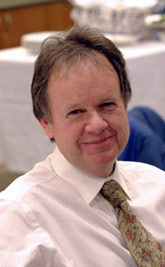
Handy Links
SLAC News Center
SLAC Today
- Subscribe
- Archives: Feb 2006-May 20, 2011
- Archives: May 23, 2011 and later
- Submit Feedback or Story Ideas
- About SLAC Today
SLAC News
Lab News
- Interactions
- Lightsources.org
- ILC NewsLine
- Int'l Science Grid This Week
- Fermilab Today
- Berkeley Lab News
- @brookhaven TODAY
- DOE Pulse
- CERN Courier
- DESY inForm
- US / LHC
SLAC Links
- Emergency
- Safety
- Policy Repository
- Site Entry Form

- Site Maps
- M & O Review
- Computing Status & Calendar
- SLAC Colloquium
- SLACspeak
- SLACspace
- SLAC Logo
- Café Menu
- Flea Market
- Web E-mail
- Marguerite Shuttle
- Discount Commuter Passes
-
Award Reporting Form
- SPIRES
- SciDoc
- Activity Groups
- Library
Stanford
Around the Bay
From the Chief Research Officer: The Annual Lab Planning Process

As you may know, each year SLAC scientific and operational leadership evolves a Ten Year Strategic Plan. This plan clearly defines how the SLAC vision will be carried forward in the upcoming years. We discuss and use this plan with the Department of Energy Office of Science to ensure congruency with the prime provider of our funding. Through this plan, we seek to coordinate and differentiate SLAC's roles, relative to other Office of Science laboratories, by identifying our areas of sustainable, world-leading core science areas and scientific facilities (which are referred to as laboratory core capabilities).
One of the roles and responsibilities of the Chief Research Officer is to coordinate the science and technology component of the SLAC Ten Year Strategic Plan. This is managed in very close coordination with the mission support functions of the SLAC Operations Directorate. DOE refers to the document and process as the "Annual DOE Laboratory Plan."
The Annual Lab Plan is the strategic planning process used by the DOE Office of Science through their Office of Laboratory Policy and Evaluation. There are two components to the annual planning process, a written plan and a follow up visit and presentation to DOE Office of Science representatives by the director (Persis), COO (Sandy) and CRO (myself). We are just beginning the FY10 cycle. Since this involves many areas at SLAC and many of you will be involved in realizing the plan for FY10, I thought an overview might provide a useful perspective.
Each year, the Office of Science provides detailed guidance on the contents of the plan and what is expected from each of its laboratories. In fiscal year 2010, stated goals include asking the respective leadership teams to define an exciting yet realistic long-range vision for the future of their laboratory. The written plan is intended to serve as a "starting point for a discussion between Office of Science leadership and the laboratory about the lab's future directions, strengths and weaknesses, immediate and long range challenges, and resource needs." It is this discussion, which is the focus of the visit by lab management back to DOE in Washington, a large number of the upper Office of Science management will participate (for an overview of management members, see this organizational chart).
A high level look at the organization of the plan quickly illustrates that it includes science and technology mission and operations/mission support components. The first part gives a high level overview, describes the core capabilities of the laboratory and discusses the science strategy for future, major initiatives. The later sections focus on the laboratory's infrastructure and mission readiness, its workforce and cost of doing business. As you can see, the plan engages all of the directorates of SLAC. If you are interested, the FY2009 Plan is available online (SLAC internal).
The FY10 Plan will build upon that from earlier years, but will be updated to reflect new opportunities that are emerging from our developing programs and bold new vision. Describing how excellence in operations and mission support enables us to deliver new scientific capabilities and discovery is an important objective. The ALDs, supported by their management teams and staff, are working now on the mission elements of the plan. (This is the area coordinated by the CRO.) The business, infrastructure and financial elements are being coordinated through the Operations Directorate, where Charlotte Chang has the overall responsibility, and many of you will also be involved. Over the coming month, drafts will be developed and integrated with the goal of finalizing the new plan by mid-May (to be followed by the visit to DOE in June).
Thank you in advance for your help and support in developing the FY10 Ten Year Strategic Plan for SLAC. I will let you all know when it is completed and available.
